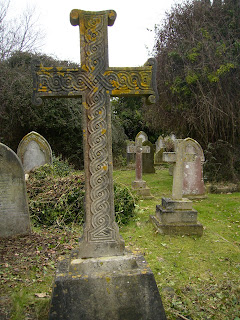



This week was our first visit to Ryde Cemetery and we had a good turnout on a dry if cloudy day. The Ryde Cemetery Restoration project initiative aims to conserve and restore the area to its former Victorian glory, by repairing and restoring the original Victorian Chapels, key historic tombs, historical walls and railings; ensuring the cemetery is conserved for the long term; training to increase heritage skills; encourage its appreciation as a heritage site; create a conservation area and potentially a local nature reserve. It is also hoped the project will enhance the ecological heritage value of the cemetery, which is rich in wildflowers and provides a home to butterflies, foxes, bats, other birds and mammals. We certainly found some very interesting looking spiders, together with a very small bee which was fluttering its wings very rapidly to get warm - we put him in a nice dry spot under a big tree, so hope he will survive. Some of the tombs and monuments are absolutely amazing with some beautiful carvings (see photo), it’s just like walking into a history book. We found representations of all three armed services including a Flying Officer Osborne from 1941 and a Colonel Charles Hunter of the Royal Artillery from 21 February 1916 which was the first day of the Battle of Verdun.
Carrie’s History Lesson: Ryde Cemetery is older than any other on the Island, predating the Burial Act of 1853 by more than ten years. In September 1840 George Player, Lord of the Manor, offered Newchurch Parish one acre of free land in Ryde, with the first internment in 1841, and official opening in 1842 when the chapel dedicated to St Paul was consecrated. The original part is believed to have been laid out on the site of an old sandpit, and the Ordnance Survey of 1862-63 shows several excavations labelled sandpits to the north. In 1861 two new chapels were built, one Church of England the other Non-Conformist, with the chapel dedicated to St Paul becoming the town mortuary. It was enlarged in 1862 with a portion set aside for Roman Catholics, consecrated by Bishop Grant in 1863. A second large extension took the burial area out to Pellhurst Road to the west, but there have been no significant changes since 1939 and at present there is no room for new burial spaces.
Many thanks to Carrie for the text & photographs.

No comments:
Post a Comment